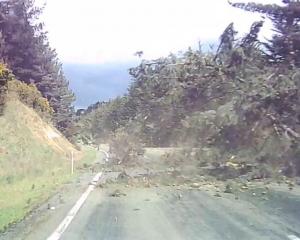
The dune's long-term future was good, coastal erosion expert Dr Wayne Stephenson said, and there was virtually no risk to property due to erosion this year.
"Unless an asteroid lands off the coast and generates a mega-tsunami, a breach of that dune? I just can't see that happening.''
This year's violent spring and winter storms caused considerable damage to Dunedin's seaward coast, from St Clair to Middle Beach.
The St Clair Surf Life Saving Club's temporary boat ramp had been obliterated, a 12-tonne concrete ramp ''unhinged'' from the St Clair seawall, sand had been stripped from St Clair Beach, a number of the beach's historic groyne poles had vanished, and the dune system had been significantly eroded.
At the dune's peak, above Victoria Rd between the surf club and the St Clair Scout Hall, a significant amount of land had succumbed to the sea, St Clair resident Bill Brown said.
By using a mature macrocarpa tree as a reference point, Mr Brown began in July repeatedly measuring the distance from that tree to the edge of the dune's top.
As reported in the ODT last month, his measurements showed 8.7m of the dune's top, including foliage, had vanished between the surf club and the scout hall in the four weeks to August 6.
At the time he said just 12m separated the edge of the dune's top to the nearest building.
But that distance ''just keeps getting shorter and shorter'' Mr Brown said this week. His measurements showed another 3.4m had disappeared between August 6 and August 30.
That information was brought before the Dunedin City Council this week by Dunedin resident Lyndon Weggery, who said Mr Brown's research had shown erosion was continuing and action needed to be taken immediately.
But Dr Stephenson told the ODT yesterday the important issue was what was happening at the bottom of the dune, more so than the top.
If the dune's ''foot'' was staying largely in place - ODT aerial photographs taken yesterday showed that was the case - the receding top was simply changing the gradient of the dune.
That decreasing gradient would make the dune more stable and lead to a declining rate of retreat of the dune's top, he said, and Mr Brown's figures appeared to illustrate that.
He said research had shown that despite appearances, there had been no significant long-term erosion at St Clair Beach for 120 years.
The high tide line had not moved in that time, although short-term fluctuations were to be expected and at times could be significant.''
We've just happened to have a storm that's bitten into the sand dunes this time.''
St Clair's dunes were ''entirely artificial'', he said, as a result of marram grass planted more than a century ago and other examples of people ''mucking around with it''.
That had left the dunes artificially high and steep, meaning any erosion they suffered looked ''terrible''.
But the Dunedin City Council's plan of attack, which included sand sausages, sand replenishment, and more permanent features in coming years, appeared a ''perfectly reasonable'' response to St Clair's problems, Dr Stephenson said.
The DCC's response to the May and June storms gathered pace this week as contractors began installing plastic sheet piling to the seaward side of the surf club's temporary boat ramp, at the northern end of the promenade.
The piling would shore up the wall and stop the ramp's rocks rolling into the sea.
DCC parks, recreation and aquatics group manager Richard Saunders said damaged sand sausages would be repaired and new ones installed in the coming months. Sand dredged from the Otago Harbour was being stockpiled at Middle Beach to fill the new sand sausages and replenish the stripped dunes.
That work was to be completed before next winter's storms and more permanent work, which could include a buried backstop wall, would occur in coming years.












